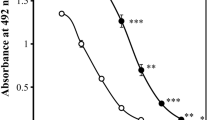Summary
Utilizing multiperforated capsules implanted in tissue, the concentrations of cephalothin, cefazolin and cefamandole in soft tissue interstitial fluid and renal interstitial fluid were measured simultaneously and compared with concentrations found in serum and urine in dogs. Antibiotic concentration in renal interstitial fluid was less than urinary levels but exceeded serum concentrations. A direct time-concentration relationship of these three structurally related antibiotics with different protein-binding in serum and renal interstitial fluid was found. This model helps illuminate the basic pharmacokinetics of antibiotic in the renal interstitium where pyelonephritis occurs.
Zusammenfassung
Mittels implantierter perforierter Kapseln wurde die Konzentration von Cephalotin, Cephazolin und Cefamandol in der interstitiellen Flüssigkeit des Subkutangewebes und der Niere gemessen und mit der Konzentration im Serum und Urin bei Hunden verglichen. Die Antibiotika-Konzentration in der renalen interstitiellen Flüssigkeit war niedriger als im Urin, überstieg aber die Serumkonzentration. Die drei strukturell ähnlichen Antibiotika mit unterschiedlicher Eiweißbindung im Serum und in der interstitiellen Flüssigkeit der Niere zeigten eine direkte Zeit-Konzentrationsabhängigkeit. Dieses Modell trägt zum grundsätzlichen Verständnis der Pharmakokinetik im Niereninterstitium bei, in dem sich die Pyelonephritis abspielt.
Similar content being viewed by others
Literature
Stamey, T. A., Govan, D. E., Palmer, J. M. The localisation and treatment of urinary tract infections: The role of bactericidal urine levels as opposed to serum levels. Medicine 44 (1965) 1–36.
McCabe, W. R., Jackson, G. G. Treatment of pyelonephritis: Bacterial, drug and host factors in success or failure among 252 patients. N. Engl. J. Med. 272 (1965) 1037–1044.
Cockett, A. T., Moore, R. S., Roberts, A. P. Distribution of some newer antibiotics within the kidney interstitium: A therapeutic consideration in pyelonephritis. Invest. Urol. 5 (1967) 250–259.
Currie, G. A., Little, P. J., McDonald, S. J. The localisation of cephaloridine and nitrofurantoin in the kidney. Nephron 3 (1966) 282–288.
Tune, B. M. Effect of organic acid transport inhibitors on renal cortical uptake and proximal tubular toxicity of cephaloridine. J. Pharmacol. Exp. Ther. 181 (1972) 250–256.
Schlegel, J. U., Burden, J. J. Studies in the treatment of acute pyelonephritis. J. Urol. 91 (1964) 127–130.
Landes, R. R., McCormick, B. H., Grahem, R. H., Melnick, I. Cephaloridine: A new broad spectrum antibiotic. Effectiveness in urogenital infections. J. Urol. 97 (1967) 147–152.
Guyton, A. C., Granger, H. J., Taylor, A. E. Interstitial fluid pressure. Physiol. Rev. 51 (1971) 527–563.
Chisholm, G. D., Waterworth, P. M., Calnan, J. S., Garrod, L. P. Concentration of antibacterial agents in interstitial tissue fluid. Br. Med. J. 1 (1973) 569–573.
Waterman, N. G., Kastan, L. B. Interstitial fluid and serum antibiotic concentrations. Arch. Surg. 105 (1972) 192–196.
Waterman, N. G., Scharfenberger, L. Antibiotic concentrations in hepatic interstitial and wound fluid. Surg. Gynecol. Obstet. 142 (1976) 235–238.
Sabath, L. D., Casey, J. I., Ruch, P. A., Stumpf, L. L., Finland, M. Rapid microassay for circulating nephrotoxic antibiotics. Antimicrob. Agents Chemother. 10 (1970) 83–90.
Waterman, N. G., Scharfenberger, L., Raff, M. J. Rate of binding of antibiotics to canine serum protein. Antimicrob. Agents Chemother. 5 (1974) 294–295.
Lilly Research Laboratories: Cefamandole nafate. Clinical investigation manual (No. 089). Eli Lilly and Co., Indianapolis, 1974.
Shibata, K., Fujii, M. Clinical studies of cefazolin in the surgical field. Antimicrob. Agents Chemother. 10 (1970) 467–472.
Eickenberg, H. U., Scharfenberger, L., Waterman, N. G. Concentration of antibiotics in renal interstitial fluid, soft tissue interstitial fluid, urine and serum. Infection 4 Suppl. 2 (1976) 97–102.
Eickenberg, H. U.: What is interstitial fluid? Biochemical and physiological analysis of fluid obtained from tissue cages. Scand. J. Inf. Dis. Suppl. (1978) in press.
Waterman, N. G., Raff, M. J., Scharfenberger, L., Barnwell, P. A. Protein binding and concentrations of cephaloridine and cefazolin in serum and interstitial fluids of dogs. J. Infect. Dis. 133 (1976) 642–647.
Author information
Authors and Affiliations
Rights and permissions
About this article
Cite this article
Eickenberg, H.U. Concentration and protein binding of cephalosporins in renal interstitial fluid, soft-tissue interstitial fluid, urine and serum. Infection 6 (Suppl 2), S233–S237 (1978). https://doi.org/10.1007/BF01638980
Issue Date:
DOI: https://doi.org/10.1007/BF01638980




